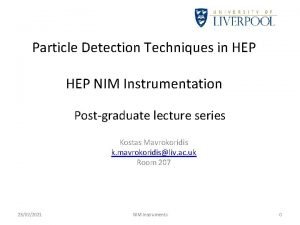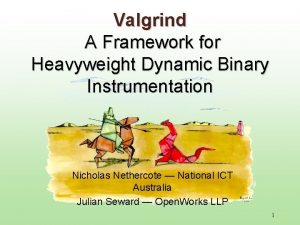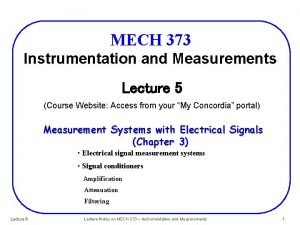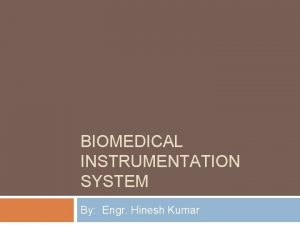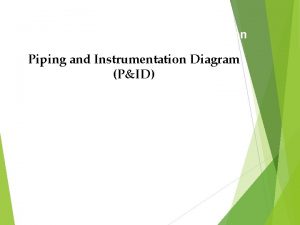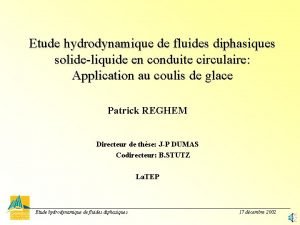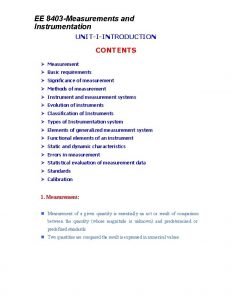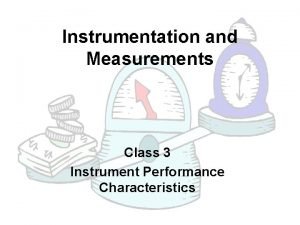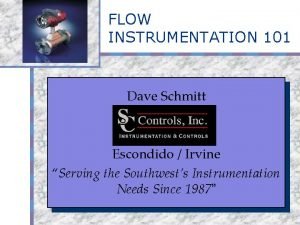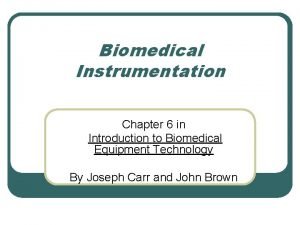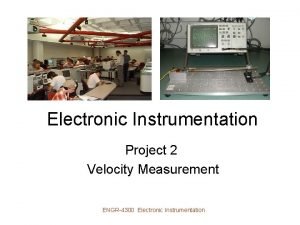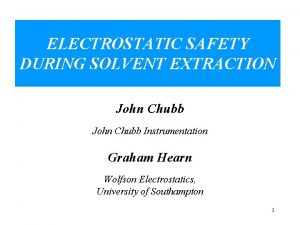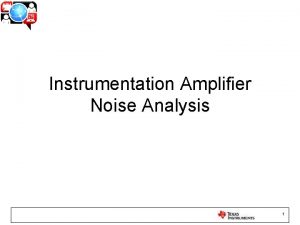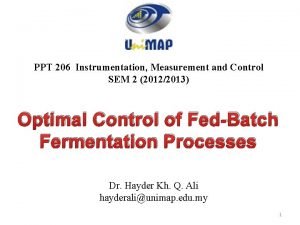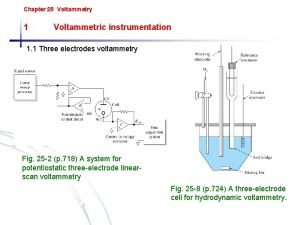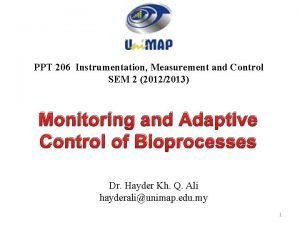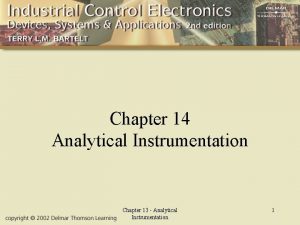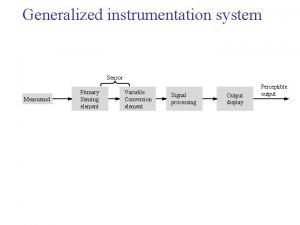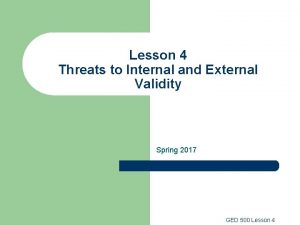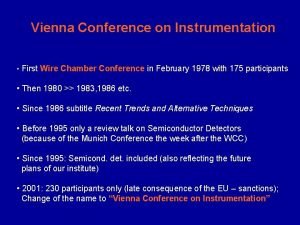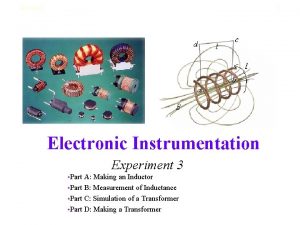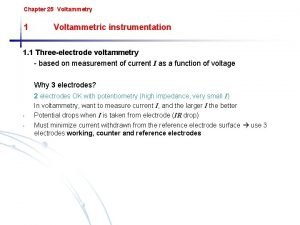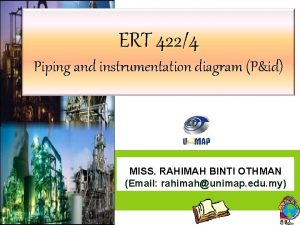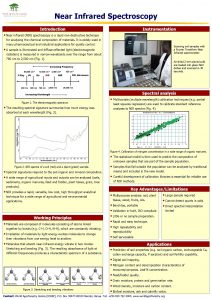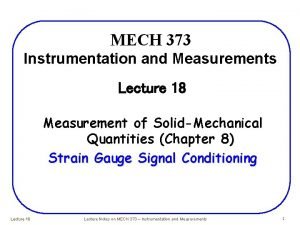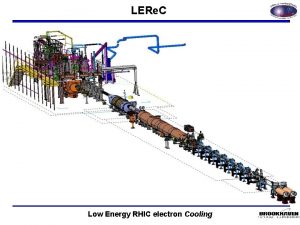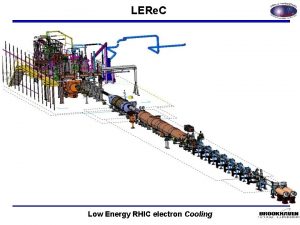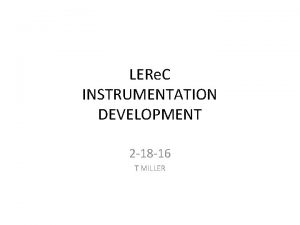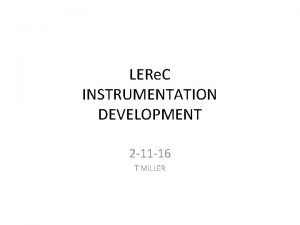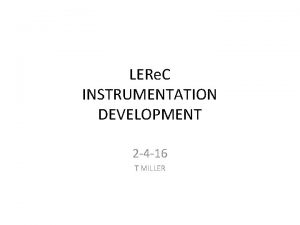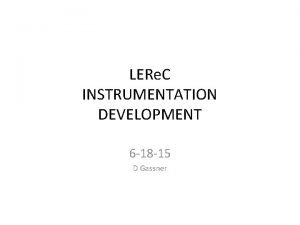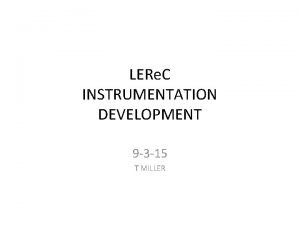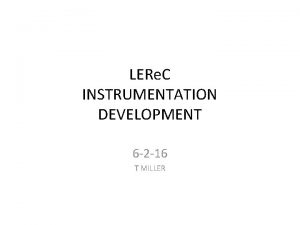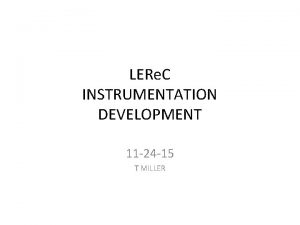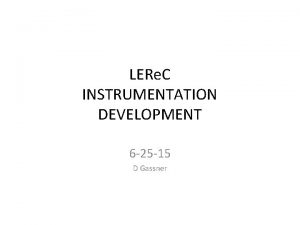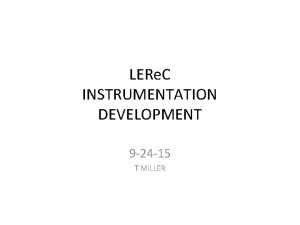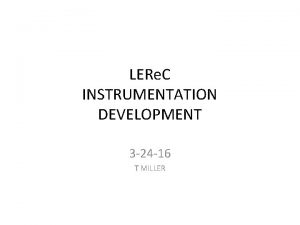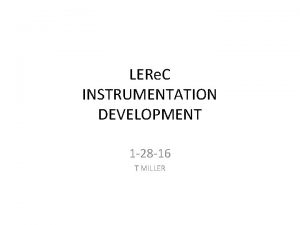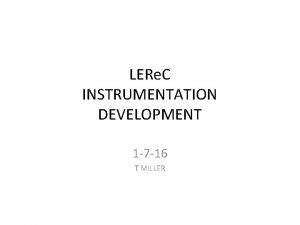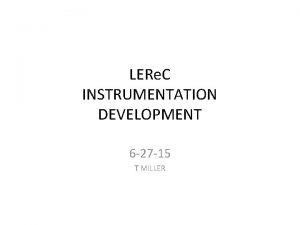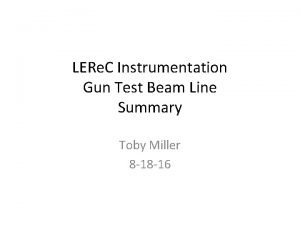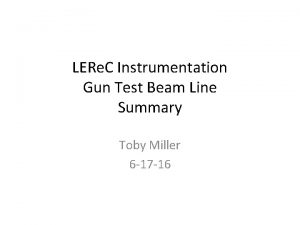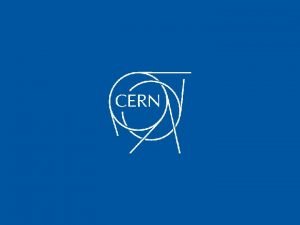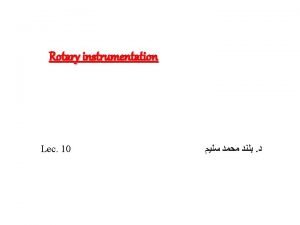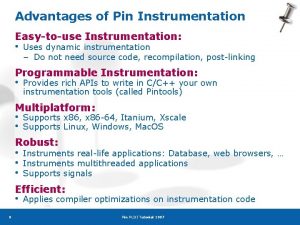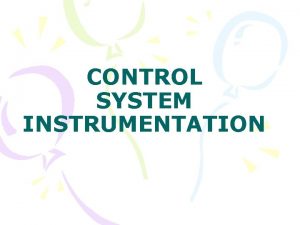LERe C INSTRUMENTATION DEVELOPMENT 12 17 15 T



























- Slides: 27

LERe. C INSTRUMENTATION DEVELOPMENT 12 -17 -15 T MILLER

Topics • Laser transport: fiber or vacuum duct? • 9 th BPM in cooling section deleted. – Can we guarantee angle of beam into 180° dipole? Enough BPMs? • Gun cathode imaging mirrors – Fixed mirror with new viewport • GUN BPMs – 15 mm buttons from MPF • 1. 33” CF • short as possible – bunch phase measurement in the gun section vs. laser phase measurement reflected off the cathode. • If detector is mounted at laser exit port, how can we steer the laser on the detector after the laser is steered on the cathode? • Do we need a dedicated button pick-up? • Commissioning Beam Line Location • Beam Rastered Profile Monitor – Experience with HARP wire system • Lensing problem with 180 degree dipole. – Need for additional quadrupoles – Or live with asymmetric beam profile

Machine Layout 64 m to IP 2 Commissioning Diagnostic Line 1 704 MHz Cu Cavity e- COOLING in Yellow RHIC ring RHIC TRIPLET e 180° Bending Magnet 2. 1 GHz Cu Cavity 9 MHz Cu Cavity RHIC DX COOLING in Blue RHIC ring 20° Bending Magnets Beam Dump Symbolic Layout of Instrumentation 3 704 SRF Booster Cavity DC e- Gun

Scope: Injection YAG Cathode Camera BPM Faraday Cup BPM YAG BPM Solenoid(s) BPM DC Gun (Photocathode) DCCT Injection BPM = 6 YAG = 3 ICT = 1 DCCT = 1 Em-Slit ICT Vertical & Horizontal Halo Monitors & Pick-Ups 704 MHz SRF Booster 2. 1 GHz Warm Cavity Emittance Slit = 1 Halo Pairs = 2 Faraday Cup (& pick-ups) = 5 4 Laser Injection Port

Scope: Transport YAG BPM BPM BPM 704 MHz Warm Cavity BPM Quadrapole(s) 2 locations e-Beam Transport BPM = 8 YAG = 1 5 BPM Solenoid(s) 11 locations 2. 1 GHz Warm Cavity

Merger Beam Line To Commissioning Flying YAG Wire Beam Line From Electron Transport BPM To Cooling Section Au Ion Beam Yellow Ring e-Beam Transport BPM = 2 YAG = 1 Flying Wire = 1 6

Commissioning Beam Line Beam Sampling Technique for high power single macro bunch measurements LASER Kicker YAG & Slit RF Settling Time ~250μs Full power on dump HVDC Deflector Faraday Cup Scanning YAG Profile Monitor Commissioning B/L YAG = 3 Faraday Cup = 1 Defining Slit = 1 Instrumentation Exposure ~10μs Solenoid Medium Power Beam Dump Fixed YAG er erg M To ction Se (Full Power ~250μs) Deflecting Cavity (704 MHz) Beam Sampling Technique: Dumps all beam before RF cavity steady state condition is reached; thereby providing low average power samples representative of steady state high power beam. 7 From Transport Section

Scope: Cooling Sections Scanning Em-Slit Combined BPM + YAG +Slt YAG High-field Solenoid In from Merger 180 Deg Dipole Combined BPM + YAG +slit Scanning Em-Slit YAG BPMs (16) Cooling Sections BPM = 16 YAG = 6 Scanning Em-Slit = 2 Energy Spread Slit = 1 8 YAG Out to Extraction

Scope: Extraction Blue Ring Au Ion Beam From Cooling Section BPM Extraction BPM = 2 YAG = 1 Wire scanner Defocusing Quadrapole Faraday Cup (Beam Dump) YAG DCCT BLM Cage for loss distribution measurement DCCT = 1 Faraday Cup = 1 Wire scanner = 1 9

Emittance -06 -06 Multi-Slit -06 Emitt anc. . . YAG YAG -06 Scanning H+V Slit -06 +00 Envelope 5. 00 E-03 4. 00 E-03 YAG meters 3. 00 E-03 Ne YAGs YAG YAG Envelope X YAG Flying Wire 2. 00 E-03 1. 00 E-03 0. 00 E+00 -1. 00 E-03 10 Envelope Y Elements

Main Beam Line YAGs Transport Section: 25 x 15 mm YAG Ø 12. 5 mm (@2. 5σ) Injection Section: 25 x 15 mm YAG Ø 9. 1 mm (@2. 5σ) Gun Section: 25 mm YAG Ø 10. 75 mm (@2. 5σ) 5. 00 E-03 Envelope 4. 00 E-03 Cooling Section: 45 mm YAG Ø 19 – 22 mm (@2. 5σ) New YAGs YAG YAG 3. 00 E-03 Merger Section: 25 x 15 mm YAG Ø 2 mm (@2. 5σ) Diagnostic Beam Line: 40 mm YAG Ø 15. 5 mm (@2. 5σ) Extraction Line: 40 mm YAG Ø 30 mm (@2. 5σ) YAG Envelope X YAG Flying Wire 2. 00 E-03 1. 00 E-03 YAG . 00 E+00 1. 00 E-03 11 Envelope Y Elements

Commissioning Beam Line YAGs Simulated image on YAG from Deflecting Cavity Commissioning Beam Line: (Long. Ph. Mon) 45 mm YAG ~20 x 20 mm Commissioning Beam Line: (Scanning YAG) 30 mm YAG Ø 3. 25 mm(@2. 5σ) Commissioning Beam Line: (PM with slit) 30 mm YAG Ø 10 mm(@2. 5σ) sx=1. 3 mm sy= 0. 3 mm sx/sy=4. 3 Insertable YAG sx=2 mm sy= 2 mm Dog leg Dipole off 122 cm Solenoid B=0 G Dipole off 10 cm YAG & Slit Scanning YAG sx=0. 65 mm sy= 0. 65 mm 10 cm Dipole Solenoid B=245 G Solenoid B=260 G 12 2. 5 m Static deflection plates Gap=2 cm, max. V=1. 5 k. V, L=50 cm

0 E+00 Dispersion Increased Dispersion(x) with 2 merger solenoids OFF 1. 00 E+01 2. 00 E+01 3. 00 E+01 4. 00 E+01 5. 00 E+01 6. 00 E+01 7. 00 E+01 8. 00 E+01 9. 00 E+01 x. Dispersion y. Dispersion Energy Spread YAG Defining Slit Energy Spread rms Minimum Energy Spread Maximum Energy Spread 13

Cathode Imaging • Add plunging mirror with camera & optics • New space available here. • Rotate vertical.

DC Gun

NMR Probe for 180° Dipole feedback on magnetic field • NMR Probe – 50 m. Gauss/195 Gauss (3 x 10 -4) – 2. 5 Hz measurement rate – Tests underway • Lengthen probe & bend away from beam plane • Reduce noise from 50 m. Gauss down to 20 – RFQ for integrated magnet power supply

LERe. C BPM Testing • Long term temperature tests predict cables or splitters to be temperature sensitive. Temperature Position • 700 MHz pulser on loan from laser group will be used to test button response for transport line

VISIT to JLAB 12/11/15 • Purpose/Goal of meeting: BNL is interested in JLab’s insight into safe operation of a low energy, high current accelerator. There will be presentations on beam diagnostics, feedback, and machine protection systems as well as low level RF control and their interactions. The meeting has plenty of time discussion so individual talks may slip in the scheduled time. • Meeting will be held in the LERF (BLDG 18) break room 0830 Welcome Andrew Hutton 0845 LERe. C Overview Toby Miller 0930 LERe. C Low Level RF Kevin Smith 1000 Break 1030 LERF Tour Kevin Jordan/Tom Powers 1100 Physics, 2 Me. V source/beam line David Douglas 1200 Lunch in cafeteria 1330 JLab LLRF System Curt Hovator 1400 JLab Diagnostics & Feedback John Musson (Trent Allison) 1430 LERF MPS/DLPC Kevin Jordan 1500 Discussion Time until 1700 1800 No host diner at Crab Shack BNL Attendees: Toby Miller David Gassner Zeynep Altinbas Kevin Smith Kevin Mernick JLAB Attendees: Andrew Hutton Kevin Jordan Tom Powers Curt Hovator John Musson Trent Allison

High Power Profile Monitor High Power • Compact offset cam design • 9 μm carbon fiber @ 20 m/s • accelerate/coast/decelerate • PMT detects X‐rays generated by the scattered electrons • • • Design Reliability? Performance Study? Alternatives? • REQUESTED QUOTE FROM CORNELL Photo courtesy of B. Dunham, Cornell

Rastered Beam Profile Monitor • • Carbon Wire Harp processing electronics PMT secondary pick-up 60 Hz beam scan in single macrobunch mode

Longitudinal Phase Space Monitor – Commissioning Beam Line Dog leg Dipole off 704 MHz Vertical Deflecting Cavity – Used for optimization and monitoring of phase and amplitude of the – – 122 c m LERe. C RF systems. Scaled from Cornell ERL Injector 1. 3 GHz design. Time varying vertical deflection of bunch from head to tail. Combined with horizontal dispersion from bending magnet (Dx = 1 m at YAG) provides position (time) resolved energy spread along bunch. Very low RF power <500 W at highest beam energy. • Energy Spread – 500μm width on YAG = 1× 10 -3 energy spread (Δρ/ρ) – 100μm resolution on YAG = resolutions of 5% of max Δρ/ρ • Bunch Length – 30 mm on YAG (100μm resolution ) with 3 cm bunch length – Resolution of 30 mm / 100μm = <0. 5% of bunch length Simulations Courtesy of D. Kayran To Electrostatic Energy Spectrometer 2 m Deflecting Cavity (704 MHz) Medium Power Beam Dump (Full Power ~250μs) Solenoid Dipole B=260 G Beam Image on YAG S. Belomestnykh, et al. , “Deflecting cavity for beam diagnostics at Cornell ERL injector, ” Nucl. Instrum. & Methods A 614 (2010) 179 -183. Pulsed Electrostatic Deflector (Kicker) 10 cm Beam’s Initial Longitudinal Phase Space 2 m Solenoid Fixe d YAG Solenoid B=0 G From Transport Section Bunch Length • sx=1. 3 mm sy= 0. 3 mm sx/sy=4. 3 ~500μm sy= 5. 6 mm sz= 32 mm Δρ/ρ Cavity On Cavity Off Deflecting cavity: U=12 k. V f=704 MHz L=2 m 21

Absolute Energy Measurement – Commissioning Beam Line Current approach: • ~2 k. V electrostatic deflecting electrodes • Scanning YAG screen (+/- deflection) over 100 mm • Calibration using Tandem ion accelerator • Expected resolution: – – Insertable YAG sx=2 mm sy= 2 mm Dipole off YAG & Slit Scanning YAG sx=0. 65 mm sy= 0. 65 mm 10 cm Solenoid B=245 G 50μm optical resolution ÷ 100 mm deflection = 5× 10 -4 which can be improved to compensate for noise with a fixed zoom lens. By centering the spot on the screen using Center-of-Gravity image analysis, the sub-micron scan position gives the absolute energy. 2. 5 m Static deflection plates Gap=2 cm, max. V=1. 5 k. V, L=50 cm All Particles through beam line 3 mm iris 37% transmission Pipe 6 cm 2. 38” ID Scanning YAG Monitor solenoi d Deflection plates ± 1. 67 k. V Fixed Faraday Cup 1. 6 Me. V electrons ± 1. 67 k. V 7 inch travel M Simulations Courtesy of D. Kayran Dy=+/-5 cm Beam KE=1. 6 Me. V sy=. 65 mm sz=. 65 mm Static deflector: U=+/-1. 67 k. V Gap=2 cm Length=50 cm Dist. to PM=2. 5 m 22

Recombination Monitor: Ion Collection Recombination Detector – Secondary Cooling Indicator. Collection of recombined ions: • Lost at predictable location • Detector: PMT + Counter • Development underway of a lattice with a dispersion waves in the cold arcs • Roman Pot type detectors envisioned in the cryostat to collect the Au+78 ions. Recombination detector concept showing two ionization detectors mounted in retractable roman pot systems. Courtesy of Peter Thieberger 23

Deuteron Recombination Detector How to proceed? • simulations needed for blue detector Cooling section Courtesy of Peter Thieberger Ø Investigating deuteron-electron recombination for initial electron beam alignment and energy calibration. • Strong, localized signals allow detection starting far from optimal alignment. • Neutral deuterons from deuteron-electron recombination are not deflected in the arcs. • Detectors located outside of the cryostat (red rectangles) will detect these particles and the showers they produce. • Detector telescopes can be used to reduce background if necessary. • The structure of the expected showers will be studied using MCNPX simulations. • A small deflection will result after the neutral deuterium losses its electron when traversing the beam-pipe. This deflection will be calculated and taken into account.

Notes from this meeting • The LERe. C gun will be commissioned with a fiber laser transport. – – • Concerning the BPMs in the gun-to-booster section, current test data suggests requiring averaged data over 1 – 10 us long trains of macro bunches to provide 100 um position resolution using the 9 mm buttons. – – – • • We need to calculate how accurate of an angle measurement can be made adding a BPM between the hybrid device and the solenoid. To synchronize the laser to booster RF (with feedback loop) – – • A small meeting may be held with Michiko, Dave, Rob & Alexei to decide if buttons will be sufficient. We are ready to request a quote for MPF to redesign their 15 mm buttons (used at Ce. C) with a much shorter depth. We may plan to center the beam using many turns of beam for good position measurement followed by profile, emittance, energy & energy spread measurements in the single macro bunch mode. We need two BPMs between the 180 dipole and the solenoids to make an accurate beam angle measurement. – • Fear of nonlinearity in the fiber suggests an inability to reproduce the “beer can” shipped laser pulses & macro pulses. Based on experience at the JLAB FEL, we are preparing for the likelihood of needing an evacuated (or dry nitrogen filled) laser transport pipe system. we will add a photodetector to sample the laser just before entering the laser box Kevin(s) Smith & Mernick requested to add a pair of button pick-up electrodes to the laser box to provide beam based feedback to LLRF as well. Concerning imaging of the cathode, a fixed mirror and viewport is cheaper & better than a plunging one as the cathode can be imaged while producing beam. The longitudinal phase monitor (in the commissioning beam line) needs 0. 4 degree resolution for proper energy spread measurement. The current location provides roughly 5 degree resolution based on current optics simulation. – – Michiko will re-evaluate the simulated data. The entire beam line may need to move downstream of the 180 degree dipole. The optics design is waiting on a firm design and impedance analysis of the beam kicker & dump. The optics should be designed so that the beam at the center of the kicker is imaged onto the YAG screen

Notes from previous meeting on 12/3/15 • • 1 st diag. B/L magnet needs to be an ERL 30 degree dipole, 20 degree is shown in this layout. ERL aperture is actually smaller. . . maybe choose the larger aperture dipoles in the ERL dump. George to advise… Discussion of running without booster: need corrector every 1 m, or 2 layers of mumetal, or use long helmholtz coil. . . New goal to run beam without booster, through all planned instrumentation (mostly from ERL) to the FC in the first diagnostic beam line. – – • need to take care to run magnet cables so as not to generate stray fields! Don Burno will look for twisted pair power cable for magnets <20 A. It was suggested to eliminate last dipole before the beam dump. However, this will inceased back shine to the instruments. – • • need to model device for impedance Need to ask Cornel about results with titanium, is it any better than carbon? Optics studies from Dmitry show the same optics as presented to DOE in Nov. (shown here). – – • A back-up plan shall be to image the cathod through the laser entry port and steering mirror using a mirror in air on axis with the laser with an aperture for the laser to pass through. A better alternative is to simply add a fixed mirror and viewport to avoid the plunging mechanism and also allow for cathode imaging simultaneous to beam production. Request for quotation for a magnet power supply was sent today to Caylar to work with the NMR probe for feedback on the magnetic field. Concerning the Flying wire scanner, Igor suggested a carbon sheet to thermally image the profile of the beam. Peter commented that this works for beam finder but suffers from nonlinearities for an accruate profile? Could we back out the nonlinearities? – – • we may change the dump over- focusing quadurpole to a solenoid. Dmitry will look into this. will discuss during design in 2 months. . . It was suggested to elongate the laser box and incorporate the two new ports into the box instead of a cross to provide a plunging cathode imaging mirror. – • Alexei would like to install 8 k. W Ce. C beam dump to test gun next year. Plan to move the YAG (just before 704 MHz warm cavity) upstream to just after the 1 st diag. beam line for next year's test. Open question is whether or not to add BPMs to this portion of the beam line and is any Mu. Metal shielding required. John Hock is involved to apply e. Lens BPM & drift tube designs toward the deflector and kicker designs for LERe. C. Concerning the Electrostatic Energy Spectrometer, the deflector voltage will be increased toward 5 k. V so that the 2 cm gap can be enlarged to accommodate the beam. The gap will be increased to 4 cm. End. Fragment Concerning the recombination monitor, the open issue here is the choice of detector to install inside the cryostat and whether or not to make the detector moveable. A warm motion feedthrough like what is being installed on the Ce. C 700 MHz tuner may be a candidate.

Notes from previous meeting on 11 -24 -15 • CW vs Macro. Bunch beam structure – – • Cathode Imaging – • – – Joe explained during a discussion about the Ferrite modified chambers that we plan to move forward with totally new designs for the profile monitor chambers in order to match the beam line aperture and to correct for impedance. Flying Wire Profile Monitors – • Rob H announced that test results have showed excellent rejection of the 700 MHz electron signal while measuring the low frequency ion signal due to the use of the 10 MHz diplexers (see slide 6). Moreover, significant temperature dependance of the system shows the need for temperature controlled racks for the BPM electronics. One long term drift has yet to be correlated with a cause. More testing with 700 MHz trains of short bursts is necessary to investigate suspected frequency dependance of electrical center of the buttons in the cube. We are investigating faster picosecond pulses, 700 MHz ARB’s and perhaps a properly matched Goubau Line or alternative structure for testing the button cubes. ERL Profile Monitors – • Caylar reported in a video conference this morning that they are making good progress with their NMR-20 instrument and is measuring 166 Gauss with +/50 m. Gauss noise at a 2. 5 Hz measurement rate (400 msec sliding average window). Their goal is a resolution of 20 m. Guass. BPM Testing – • Proposal to add cathode imaging to Cornell Gun design via a penetrated mirror in laser entry port to image cathode along the path of the laser. This depends on the useable aperture of the laser steering mirror that would also be used for imaging the cathode. NMR Probe – • Alex reported that we are buying high power couplers capable of CW operation in the event that CW operation is required. Thus only additional RF power amplifiers would need to be added. It is not yet clear if this is an advantage or disadvantage for BPMs. Certainly, CW operation would eliminate the possibility of usingle electronics boards for ion & electron measurements. But, this would only strengthen the 700 MHz electron beam position measurement. We decided to move forward with requesting a serious quote for the procurement of TWO units from Cornell. We may be fortunate enough that single macro bunch profile measurements of the beam are representative of the high power beam BUT the Flying Wire PM is the only instrument that can provide profile measurement during operation. Longitudinal Phase Space Monitor – Kevin Mernick explained that a recent meeting was held where the parts of the commissioning beam line were assigned to people to work on, as follows. Dmitry will present the beam line optics in a meeting next week. BPMs and solenoids may need to be added. • • • Electrostatic Energy Spectrometer – • Fast Kicker – KM, MMB, KSS Internal Beam dump – JT, MMB Transverse Deflecting Cavity – BX, JT, VV (Cornell) YAG Screens, Cameras – TM Other Diagnostics (BPMs? ) – RM, RH Energy Measurement - MM Beamline Optics – DK, JK Magnet Power Supplies – DB (I’ll at least clue Don in re: this minor side project) Vacuum, Beamline Layout/Construction – JT Peter is working on the preliminary design of the deflector that an ME will be assigned to work on to aid in developing a cost estimate. I (Toby Miller) will work on estimating the YAG profile monitors and associated optics and scanning motion control for the beam line. Recombination Monitor – – – Felix has a promising RHIC lattice that can produce ~8 sigma of separation between Au+78 and Au+79 ions in dispersion bumps in the cold defocusing quads set up using the gamma t quads. A Roman Pots style detector will need to be designed to move a detector into the dispersive space of the beam. CERN is experimenting with installing beam loss monitors inside their crystats. The results could be useful here in choosing a suitable detector. Wolfram pointed out a US vendor of Diamond Detectors, Applied Diamond, Inc. He also suggested considering new Plasma Radiation Detectors being introduced by Integrated Sensors, LLC We discussed installing the double coincidence detectors for deuteron recombination detection as the detectors are outside of the vacuum. The yellow detector in the IP should work well but the blue detector has lots of material impeding the signal and will require further simulation to determine its effectiveness.
 Power supply for nim instrumentation
Power supply for nim instrumentation Valgrind pronounce
Valgrind pronounce Instrumentation and measurements
Instrumentation and measurements Block diagram of biomedical instrumentation system
Block diagram of biomedical instrumentation system Split range control คือ
Split range control คือ Instrumentation fluide frigoporteur
Instrumentation fluide frigoporteur Ee8403 measurements and instrumentation
Ee8403 measurements and instrumentation In a measuring instrument dead space is defined as the
In a measuring instrument dead space is defined as the Instrumentation 101
Instrumentation 101 Biomedical instrumentation definition
Biomedical instrumentation definition Electronique instrumentation
Electronique instrumentation Instrumentation in research
Instrumentation in research Electrostatic instrumentation
Electrostatic instrumentation Modified pen grasp in dentistry
Modified pen grasp in dentistry Instrumentation amplifier noise reduction
Instrumentation amplifier noise reduction Basics of instrumentation and control ppt
Basics of instrumentation and control ppt Cyclic voltammetry instrumentation
Cyclic voltammetry instrumentation Fundamentals of instrumentation and measurement ppt
Fundamentals of instrumentation and measurement ppt Analytical instrumentation basics
Analytical instrumentation basics Examples of primary sensing elements
Examples of primary sensing elements External validity
External validity Vienna conference on instrumentation
Vienna conference on instrumentation Electronique instrumentation
Electronique instrumentation Instrumentation of voltammetry
Instrumentation of voltammetry Lt in p&id
Lt in p&id Near infrared spectroscopy instrumentation
Near infrared spectroscopy instrumentation Special purpose amplifiers
Special purpose amplifiers Instrumentation and measurements
Instrumentation and measurements
